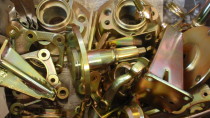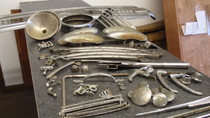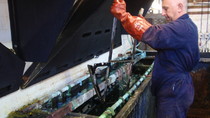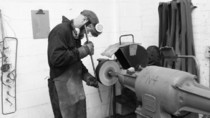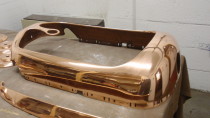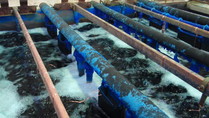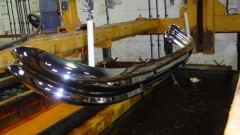The process
Booking in process
The job is fully inspected, priced, dismantled and each individual item listed.
Any arising issues are discussed, and unless the customer is a regular they will be quoted before any work is carried out.
The typical turnaround time ranges from a couple of weeks to 2/3 months depending on the job, customer requirements and work load.
We also offer, where possible, a same day turnaround for extremely urgent small parts.
Stripping process
Firstly all items are cleaned and de-greased, and any paint is removed. Any parts which are rusted are then pickled in acid.
Nickel/Chrome plated items are then stripped in an electrolytic stripper. This is done chemically such that no damage occurs to the underlying material.
It is imperative this solution is well maintained otherwise it will severely etch or destroy parts, beware of taking parts to larger commercial platers.
Polishing process
This is the most labour-intensive part of the process, and covers everything from the linishing and repairs to the final polishing.
It is a highly skilled and dangerous job, where a serious accident or major damage can occur by a moment's inattention.
All corrosion marks and imperfections are ground out, without making the metal too thin or ruining the shape. This is a process of working through different grit coarseness to progressively finer grades. The work is largely done on a variety of abrasive belts and mops driven by large 5HP motors. A range of hand tools are then used to get into the more awkward areas. The work involved varies widely depending on each individual item, and its size, shape and condition.
When the linishing stage is complete the component will usually be heavy copper plated.
After copper the item is cut back where a heavy deposit builds around the edges, and then polished up to a mirror finish. Often if items are in very poor condition the process of copper plating and re-polishing can be repeated 2 or 3 times as necessary.
Each component is finished to a mirror finish prior to plating.
Plating only looks good if the preparation is thorough.
Plating process
All our items which require it are triple plated as standard, (copper, nickel and chrome).
Copper plating is really a base layer that gives the item superior weather protection, but it also enables us to fully disguise any underlying repairs, and recover components that may otherwise be beyond repair. Its also a nice soft ductile material that can easily be polished to a high surface finish.
Items can spend anywhere between one and twelve hours in here, depending on the size and condition.
Nickel plating is either the finish in itself, or the undercoat to chrome that gives it's depth. Components stay in the nickel up to two hours, depending on what they are.
It's crucial the nickel solution is well maintained, and it can cost several thousands of pounds to replace.
The tank is continuously filtered and agitated, and contains titanium baskets of nickel slugs to replenish the nickel held in solution.
Cleanliness here is everything, a few bits or traces of grease can ruin a job!
Chrome plating is only a few microns thick. It was invented in the 1930's to stop nickel tarnishing. Items only stay in here a few minutes.
Chromic acid is one of the most harmful substances known to man, a single splash can cause severe ulcers. Health and safety are major concerns.
Cleanliness is paramount to the whole plating process.
Components will go through numerous acid dips, water swills, hot caustic scrubs and electro cleaners before and between each plating process.
This cleaning process is lengthy, but of vital importance to ensure a good result and good adherence.

